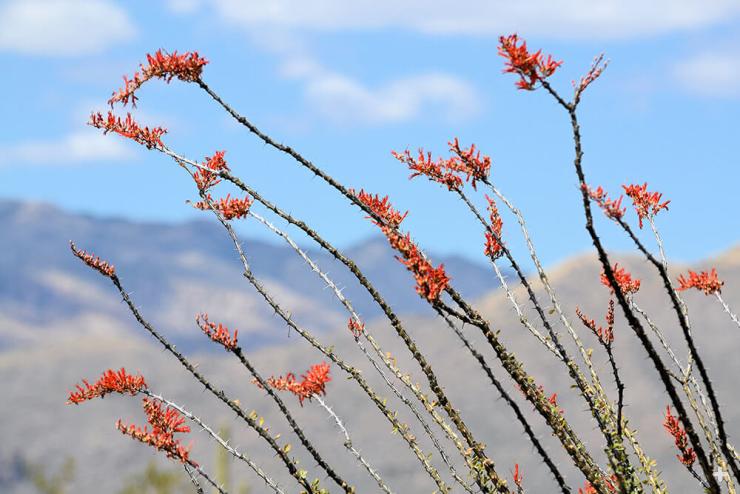Ocotillo
- DIVISION: Magnoliophyta (flowering plants)
- CLASS: Magnoliopsida (dicotyledons)
- ORDER: Ericales
- FAMILY: Fouquieriaceae
- GENUS: Fouquieria
- SPECIES: 11 (including the boojum tree F. columnaris)
OVERVIEW
Ocotillos are desert plants. Most are endemic to Mexico, but one, F. splendens, occurs into the southwestern US, and another, F. formosa, reaches into Guatemala.
In addition to having succulent (water-storing) stems, ocotillos have a second trick up their sleeve for dealing with dry times: they are drought-deciduous, meaning that they shed their leaves under drought conditions. In fact, an ocotillo plant resembles a bunch of dead, spiny sticks most of the year. When it rains, though, their spikey, slender branches get busy sprouting small, emerald leaves that make the most of moisture and sunshine. Soon after that, tubular flowers bloom at the tips of the branches. As soon as a plant becomes water-stressed, its leaves drop off, often while the flowers remain. Leaves may sprout and drop off several times during the rainy season.
Hummingbirds and native carpenter bees are pollinators that are attracted to ocotillo flowers. Ants and ground squirrels sometimes feast on the flowers, too.
At least two ocotillo species, F. ochoterenae and F. fascicularis, provide homes for epiphytic Tillandsia "air plants."
CHARACTERISTICS
An ocotillo's shallow roots spread to make the most of infrequent, seasonal rains. Each of the first leaves to grow on an ocotillo stem leaves behind a sharp spine when it falls off. With each good rainfall, a cluster of new leaves sprouts from the base of that spine.
F. splendens, the only ocotillo to grow in the US, is a tall plant with whip-like branches that curve and fan out from the base. Large specimens can reach 20 feet (6 meters) tall and 15 feet (4.6 meters) wide. Flame-colored flowers at the tips of the branches give the impression of a huge candlestick. Most ocotillos have orange or red flowers, but at least two species, F. fasciulata and F. purpusii, have white flowers.
CULTIVATION
Ocotillos are extremely drought-tolerant; they can survive on just 8 inches (20 centimeters) of rain per year. In fact, they can't tolerate much water! These spikey, spreading plants grow best in open, sunny locations in desert gardens.
USES
Sharp, spiny ocotillo branches make effective fences. Sometimes branches stuck into the ground take root, creating a living fence. In Mexico, people sometimes use ocotillo branches to reinforce house walls or to fashion the roof of a ramada (an open shelter roofed with branches).
CONSERVATION
Two of the smaller ocotillos, F. purpusii and F. fasciculata, are protected under CITES Appendix I; they are unusual plants that are attractive to collectors and have been overexploited by the horticulture industry. They also suffer from habitat loss and global climate change.
By supporting San Diego Zoo Wildlife Alliance, you are our ally in saving and protecting wildlife worldwide.











